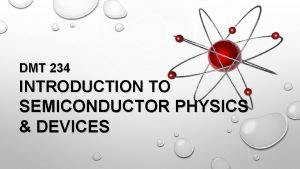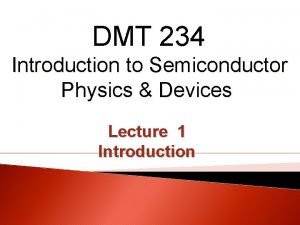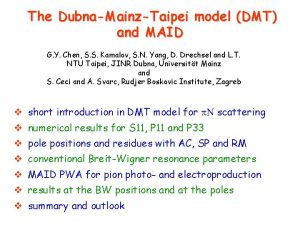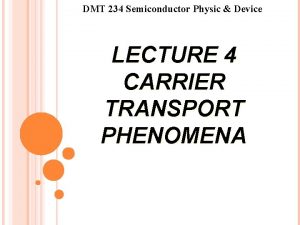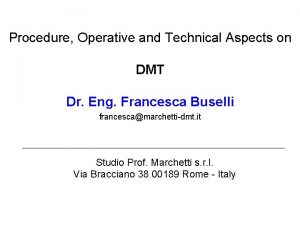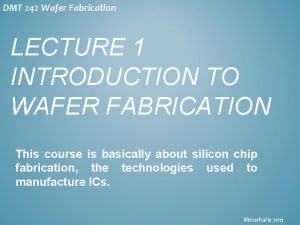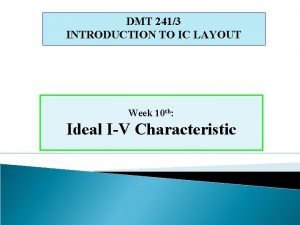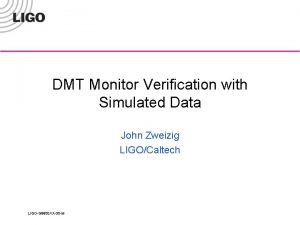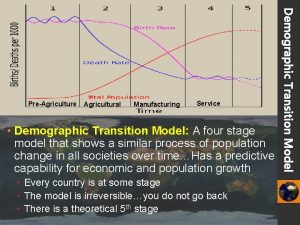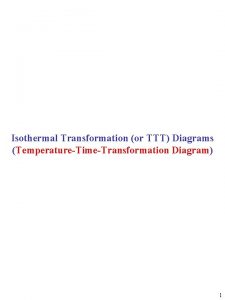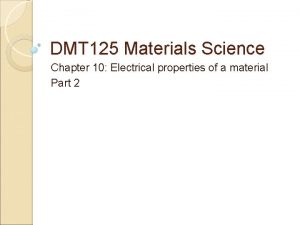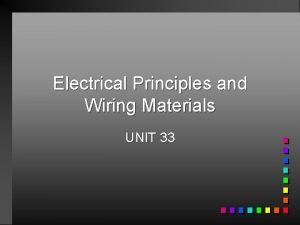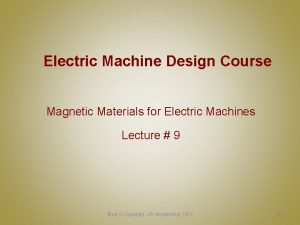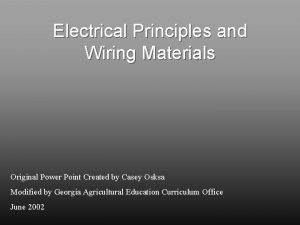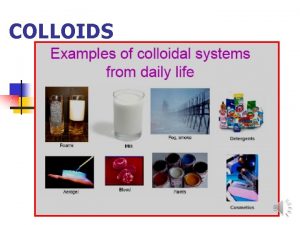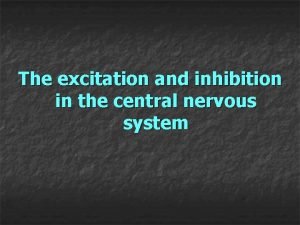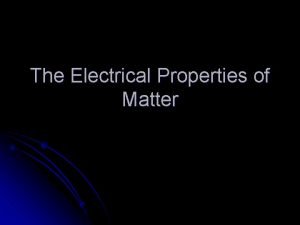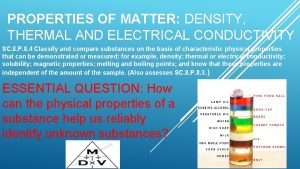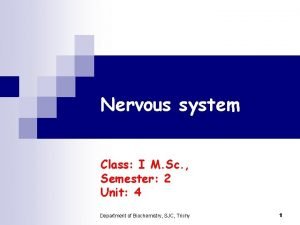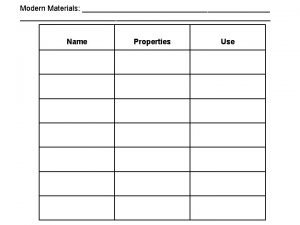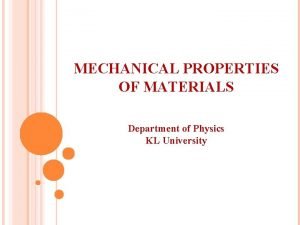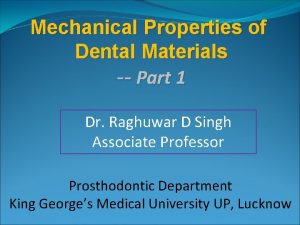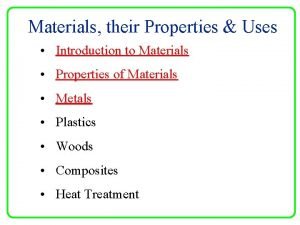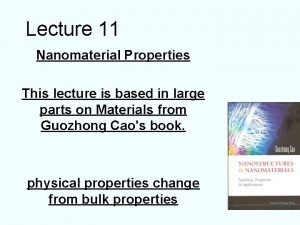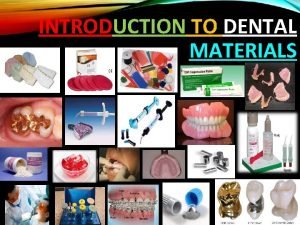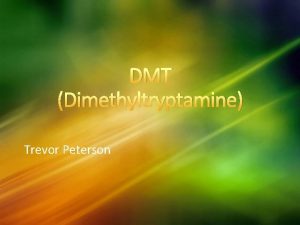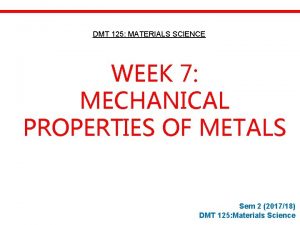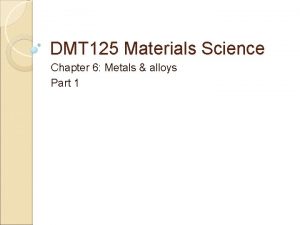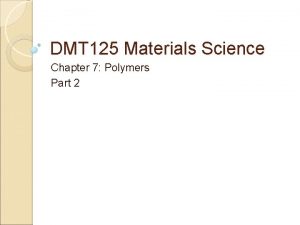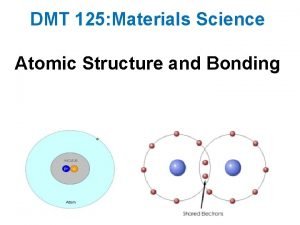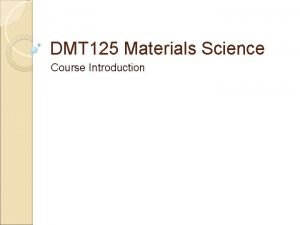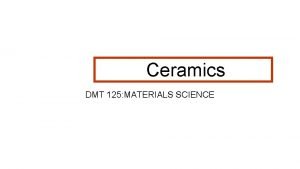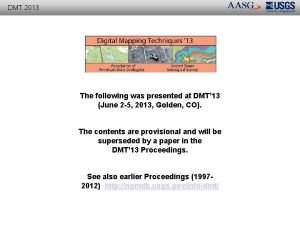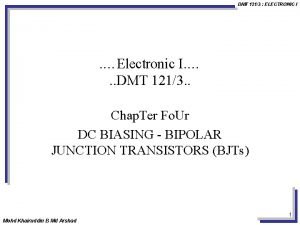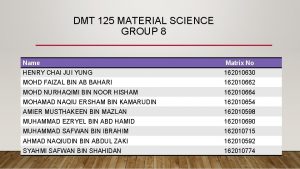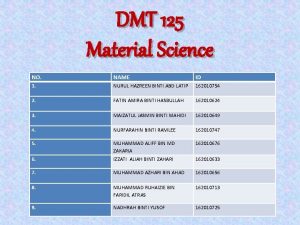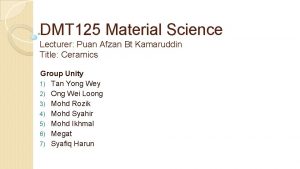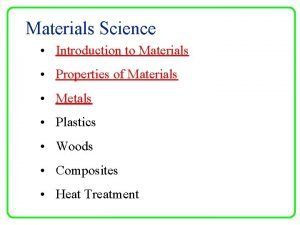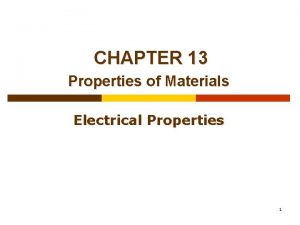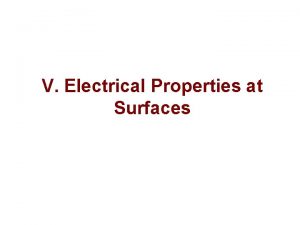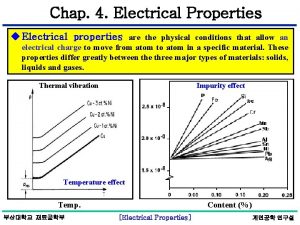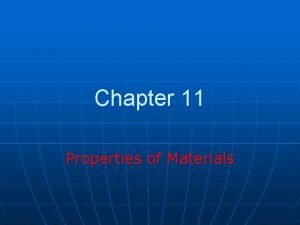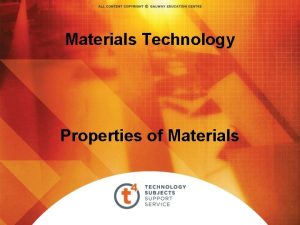DMT 125 Materials Science Chapter 10 Electrical properties



































- Slides: 35

DMT 125 Materials Science Chapter 10: Electrical properties of a material Part 2

Extrinsic semiconductors ◦ Very dilute substitutional solid solutions in which the solute impurity atoms have different valence characteristics from the solvent atomic lattice

Extrinsic semiconductors N-type (negative-type) ◦ Group 5 A impurity atoms (P, As & Sb) when added to silicon or germanium provide easily ionized electrons for electrical conduction ◦ Donate conduction electrons when present in silicon or germanium crystals Called donor impurity atoms ◦ Silicon or germanium containing group 5 impurity atoms N-type extrinsic semiconductors since majority charge carriers are electrons

Extrinsic semiconductors ◦ Donor level is at slightly below the empty conduction band ◦ Provided by a donor impurity atom ◦ Donor group 5 A impurity atom, upon losing its extra electron, becomes ionized & acquires a positive charge

Extrinsic semiconductors

Extrinsic semiconductors

Extrinsic semiconductors P-type (positive type) ◦ Group 3 A impurity atoms (B) when introduced into silicon or germanium crystal lattice, one of the bonding orbitals is missing & a hole exists in the bonding structure ◦ When the hole is filled by an electron from a neighbouring silicon atom, boron atom becomes ionized & acquired a negative charge of -1

Extrinsic semiconductors Acceptor level is at slightly higher than uppermost level of the full valence band of silicon Hole is created in the silicon lattice that acts as a positive charge carrier Atoms of group 3 A elements (B, Al & Ga) provide acceptor levels ◦ Acceptor atoms ◦ P-type extrinsic semiconductors since majority charge carriers are holes

Extrinsic semiconductors Doping of extrinsic silicon semiconductor material ◦ Doping Process of adding small amounts of substitutional impurity atoms to silicon to produce extrinsic silicon semiconductor material Dopants – impurity atoms Planar process – most commonly used method of doping silicon semiconductors Wafers usually 4” (100 mm) in diameter & few hundred micrometers thick

Extrinsic semiconductors ◦ Dopant atoms normally deposited on or near surface of wafer by a gaseous deposition step, followed by a drive-in diffusion that moves the dopant atoms farther into wafer ◦ Temperature about 1100 deg C is required for the process

Extrinsic semiconductors

Extrinsic semiconductors

Microelectronics Large-scale integrated (LSI) microelectronic circuits are manufactured by starting with a silicon single-crystal wafer (n or p-type) about 4 -6 inch diameter & 0. 2 mm thick Surface of wafer must be highly polished & free from defects Roughly 100 -1000 chips (depending on size) can be produced from one wafer

Microelectronics Planar bipolar transistors ◦ 3 fundamental parts of npn bipolar transistor Emitter, base & collector ◦ Emitter-base is forward-biased ◦ Base collector is reverse-biased

Microelectronics

Microelectronics Planar field-effect transistors ◦ Field-effect transistor is used due to its low cost & compactness ◦ Source – contact where the electrons enter ◦ Drain – contact where the electrons leave ◦ Gate – the contact between source & drain Since Si. O 2 is an excellent insulator, gate connection is not in direct electrical contact with p-type material below the oxide

Microelectronics

Microelectronics Fabrication of microelectronic IC ◦ Photolithography Process by which a microscopic pattern is transferred from a photomask to silicon wafer surface of IC The oxidized wafer is first coated with a layer of photoresist, a light-sensitive polymeric material Important property of photoresist is that its solubility in certain solvents is greatly affected by its exposure to UV radiation

Microelectronics After expose to UV, a pattern of photoresist is left wherever the mask was transparent to UV radiation Wafer is then immersed in a solution of HF acid, which remove only exposed Si. O 2 & not the photoresist

Microelectronics Figure 14. 44 Steps for photolithography process

Microelectronics Diffusion & ion implantation ◦ Selectively introduce impurities into silicon substrate to create localized n- & p-type regions ◦ 2 main techniques Diffusion Ion implantation

Microelectronics Diffusion ◦ Impurity atoms are diffused into silicon wafers at 1100 deg C ◦ Important dopant atoms (boron & phosphorus) moves slowly through Si. O 2 than through silicon crystal lattice ◦ Thin Si. O 2 patterns can serve as masks to prevent dopant atoms from penetrating into silicon ◦ The dopant atoms will enter unprotected surface of silicon & slowyly diffuse into bulk of wafer

Microelectronics

Microelectronics Ion implantation ◦ Dopant atoms are ionized (electrons are removed from atoms to form ions) & ions are accelerated to high energies through a high potential difference of 50 -100 k. V ◦ When ions strike the silicon wafer, they are embedded to varying depths, depending on mass & energy & type of surface protection of silicon surface ◦ Accelerated ions cause some damage to crystal lattice of silicon

Microelectronics Damage can be healed by annealing at a moderate temperature Advantages ◦ Useful wherever doping level must be accurately controlled ◦ Introduce dopant impurities through a thin oxide layer This technique makes it possible to adjust the threshold voltages of MOS transistors Both NMOS & PMOS transistors can be fabricated on the same wafer

Microelectronics Figure 14. 46 Steps in NMOS field-effect transistor fabrication

Microelectronics

Electrical properties of ceramics Ceramic materials are used for many electrical & electronic applications Used for electrical insulators for low& high- voltage electric currents Piezoelectrics – convert weak pressure signals into electrical signals & vice versa

Electrical properties of ceramics Basic properties of dielectrics ◦ 3 important properties Dielectric constant Dielectric breakdown strength Loss factor

Electrical properties of ceramics Dielectric constant ◦ Capacitor ◦ q = CV ◦ Unit: Farad ◦ Capacitance – measure of its ability to store electric charge ◦ More charge stored at upper & lower plates of a capacitor, higher the capacitance

Electrical properties of ceramics eo = permitivity of free space ◦ 8. 854 x 10 -12 F/m When a dielectric fills the space between the plates, capacitance is increased by a factor k

Electrical properties of ceramics

Electrical properties of ceramics Dielectric strength ◦ Measure of ability of material to hold energy at high voltages ◦ Defined as voltage per unit length (electric field or voltage gradient) at which failure occurs & thus is the maximum electric field that the dielectric can maintain without electrical breakdown ◦ unit : V/mil or k. V/mm ◦ If exceeded, dielectric material begins to breakdown & passage of current occurs

Electrical properties of ceramics Dielectric loss factor ◦ Measure of the electric energy lost (as heat energy) by a capacitor in an AC circuit

END End Copyright © Mr. Mohd. Azarulsani b. Md. Azidin April 2011
 Dmt 234
Dmt 234 Dmt 234
Dmt 234 Dmt 234
Dmt 234 Dmt
Dmt Semiconductor
Semiconductor The pythagorean theorem
The pythagorean theorem Dissipation test
Dissipation test Dmt fabrication
Dmt fabrication Layout dmt
Layout dmt Dmt monitor
Dmt monitor Population decline
Population decline Natural science grade 5
Natural science grade 5 What kind of science
What kind of science Introduction to materials science for engineers chapter 10
Introduction to materials science for engineers chapter 10 Introduction to materials science for engineers chapter 10
Introduction to materials science for engineers chapter 10 Give at least 5 tools in making simple electrical gadgets
Give at least 5 tools in making simple electrical gadgets Unit 33 electrical principles and wiring materials
Unit 33 electrical principles and wiring materials Magnetic materials used in electrical machines
Magnetic materials used in electrical machines Unit 33 electrical principles and wiring materials
Unit 33 electrical principles and wiring materials Tyndall effect is an optical property.
Tyndall effect is an optical property. Electrical properties of nerve ppt
Electrical properties of nerve ppt Electrical properties of matter
Electrical properties of matter Electrical conductivity property of matter
Electrical conductivity property of matter Sjctrichy
Sjctrichy Cant stop the feeling trolls go noodle
Cant stop the feeling trolls go noodle Household materials useful and harmful examples
Household materials useful and harmful examples Man made materials
Man made materials Adapting and adopting materials
Adapting and adopting materials Direct materials budget with multiple materials
Direct materials budget with multiple materials Physical properties of dental materials
Physical properties of dental materials Smart materials names
Smart materials names Longitudinal strain
Longitudinal strain Flexibility in dental materials
Flexibility in dental materials Malleability
Malleability Mechanical properties of nano materials
Mechanical properties of nano materials Auxiliary dental materials examples
Auxiliary dental materials examples
